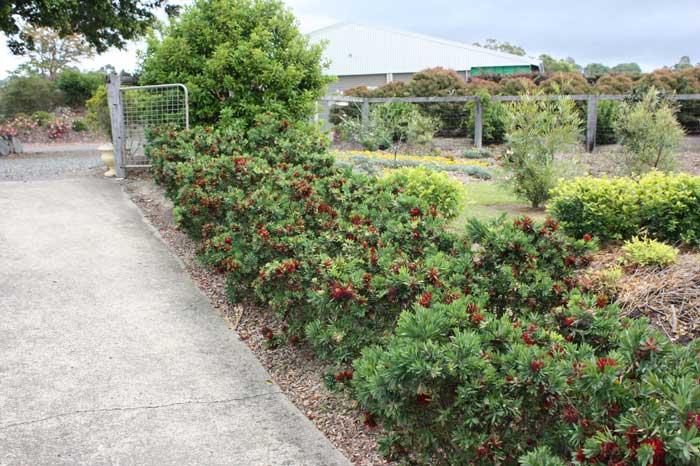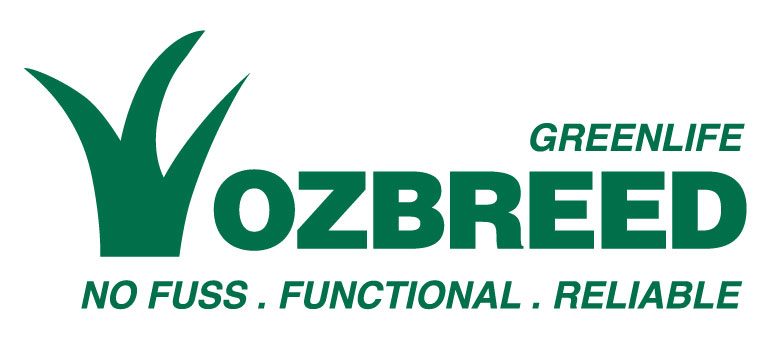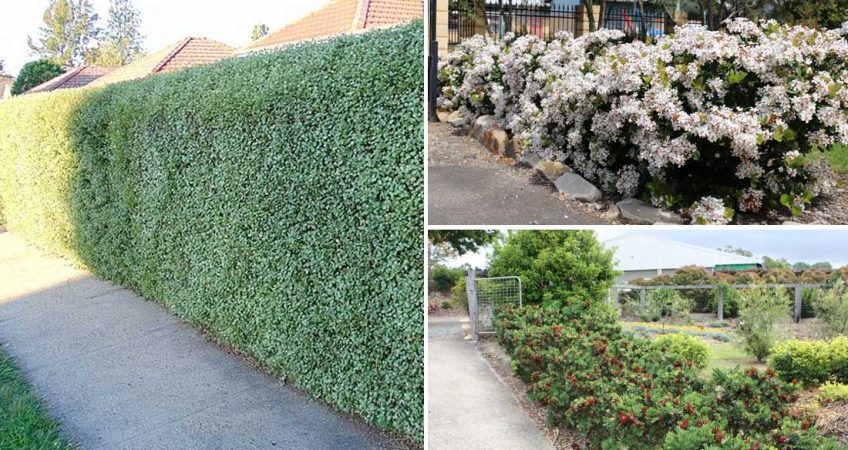Are you an avid gardener or landscaping professional looking to breathe life into a NZ garden with a vibrant, living hedge?
Perhaps you’re seeking privacy, wind protection, border definition, visual lines, or simply the aesthetic charm that only a lush green barrier can provide. If so, you’ve come to the right place.
In this article, we delve into a selection of some of the best hedge plants you can find in New Zealand, including natives and exotics. We’ll explore fast-growing options, small options, flowering options, high impact features, low maintenance options, and provide a detailed description of each plant to help you make an informed decision.
- The English box is a classic hedge plant.

Best Overall Hedge Plants in NZ
These are some of the best all-rounder hedge plants. They’ve been chosen based on their popularity, growth response to pruning, and their stereotypical “hedgeness” (to coin a phrase).
Buxus sempervirens (English Box)
This one’s a bit of a cliché, but we can’t even talk about hedges without mentioning it.
Buxus sempervirens, commonly known as English Box, is a slow-growing, evergreen shrub. It’s characterised by its dense foliage and compact habit, making it ideal for creating a well-defined hedge. The shrub’s leaves are small, ovate, and have a deep green colour that remains throughout the year.
English Box thrives best in evenly moist, well-drained loamy soil. It’s particularly valued for topiary and hedges due to its small leaves and response to pruning. It requires minimal maintenance, although occasional pruning will help maintain its shape and density.
Pittosporum tenuifolium (Kohuhu)
Pittosporum tenuifolium, or Kohuhu, is a versatile native New Zealand plant. It’s an evergreen shrub with glossy, dark green leaves that often bear a wavy margin. The plant produces small, bell-shaped flowers that are usually dark purple and emit a sweet scent.
Kohuhu is a hardy plant that can thrive in various conditions, from full sun to partial shade, and in different soil types. It’s often used as a hedge or screening plant due to its dense growth habit. Regular pruning will keep this plant compact and promote denser growth.
2. Is pittosporum the best NZ native hedge plant?

Aussie Box™ Westringia hybrid ‘WES02’ PVR (source)
Aussie Box Westringia is an evergreen shrub with a compact, rounded growth habit. It features grey-green leaves and small, white flowers that bloom most of the year, adding a touch of colour to your hedge.
It’s a hardy plant that can tolerate a range of conditions, including coastal locations and drought. They require minimal maintenance beside pruning, making them great hedges gardeners seeking a low-care hedge that won’t die as soon as you go on holiday. Semi-regular pruning will maintain its compact shape and promote denser growth.
Fast-Growing Hedge Plants in NZ
Fast-growing hedges are great for getting a result quickly, without waiting too long for your plants to grow. Their downside is that they need to be pruned more regularly as they can quickly grow out of shape.
Griselinia littoralis (Kapuka)
Griselinia littoralis, commonly known as Kapuka or NZ broadleaf, is a popular choice for hedges in New Zealand. This native evergreen shrub boasts glossy, apple-green leaves and is notably tolerant of coastal conditions and winds.
Kapuka is prized for its rapid growth rate and robust nature. It can grow up to 10m under optimal conditions, and is ideal for quickly establishing a dense, tall hedge.
Cupressocyparis leylandii (Leyland Cypress)
Cupressocyparis leylandii, or Leyland cypress, is a coniferous tree known for its columnar shape and feathery, soft foliage. Its blue-green leaves and attractive conical form make it a striking addition to any landscape.
Leyland cypress is one of the fastest-growing hedge plant. Its dense, evergreen foliage provides excellent privacy and noise reduction, making it a favourite for property boundaries.
However, as a cypress it’s susceptible to cypress canker disease and won’t reshoot if you prune into the brown parts of the branch behind the leaves.
Dense Fence™ Viburnum odoratissimum (source)
Dense Fence™ Viburnum is an improved form of sweet viburnum. It features large, glossy leaves and creates a dense screen, living up to its name.
It’s a fast-growing plant, offering rapid coverage and privacy. If you’re looking for privacy quickly, this is one of the best plants around.
Low Maintenance Hedge Plants in NZ
Low maintenance hedges have at least a couple of the following characteristics: low pruning needs, tolerance to a lack of water or nutrients, and an overall ability to withstand a “set and forget” garden maintenance approach.
Corokia cotoneaster (Wire-netting bush)
Corokia cotoneaster, known as the wire-netting bush, is a small, dense shrub native to New Zealand. It’s got wiry, interlaced branches and small, dark green leaves. The plant produces small, star-shaped yellow flowers in spring, followed by red or yellow berries.
The wire-netting bush is a hardy plant that can withstand coastal conditions, wind, and frost. It thrives in full sun or partial shade and requires well-drained soil. Its dense growth habit makes it ideal for hedging, and its low maintenance needs make it an excellent choice for busy gardeners.
This plant is not to be confused with true cotoneasters, which are a totally different plant.
Prunus laurocerasus (Cherry Laurel)
Prunus laurocerasus, commonly known as cherry laurel, is a robust evergreen shrub with glossy, dark green leaves. In spring, the plant produces spikes of white flowers, followed by small, black fruits.
Cherry laurel is a low-maintenance plant that thrives in a wide range of soil types and light conditions. It’s particularly effective when planted as a privacy hedge due to its dense growth habit. Semi-regular pruning will keep the plant compact and promote denser growth.
Better John™ Callistemon viminalis ‘LJ1’ PVR (source)
Better John™ Callistemon is a bred form of the popular Callistemon ‘Little John’. This variety stands out with its beautiful blue-green foliage and small red flowers that bloom from mid to late spring.
It’s a hardy plant that’s easier to grow and quicker to establish than ‘Little John’. It’s suitable for a range of conditions, including full sun to part shade, sandy to well-drained soils, and can tolerate drought and cold. It only needs pruning every few years to help maintain its shape and promote denser growth.
So if you’re looking for a low-growing hedge that barely needs pruning, but also flowers profusely in spring, don’t look past this Aussie native.
3. Better John bottlebrushes are one of the best low-maintenance, low-growing hedges on the market.

Small Hedge Plants in NZ
Small hedge plants are great for defining lines in the landscape, creating forms, hedging plants into shapes, and other ornamental design functions. However, they aren’t great for screening and creating privacy, due to their size.
Euonymus fortunei ‘Emerald ‘n’ Gold’
Euonymus fortunei ‘Emerald ‘n’ Gold’ is a compact evergreen shrub with striking foliage. Its leaves are variegated, boasting a brilliant gold border around a rich green centre.
This plant is low-maintenance and adaptable to a range of conditions. It grows up to 60 cm high and wide, making it an excellent choice for small hedges or borders.
Lonicera nitida (Box Honeysuckle)
Lonicera nitida, commonly known as box honeysuckle, is an evergreen shrub with dense, glossy, dark green foliage. It produces small, creamy white flowers in spring, often followed by purple berries.
Box honeysuckle is a hardy plant that can tolerate a range of conditions. It’s a fast-growing plant, usually reaching up to 1 metre in height, which makes it ideal for small hedges. Regular pruning will maintain its shape and promote denser growth.
Purple Pixie™ Loropetalum chinense ‘PEACK’ PVR (source)
This is a variety of Loropetalum chinense known for its vibrant, burgundy-purple foliage and pink fringe-like flowers that bloom in early spring to summer.
‘Purple Pixie’ is a low-growing plant, reaching only about 30-40 cm in height, and spreading up to 1.5 metres wide. It thrives in a range of conditions, including full sun to part shade, and requires well-drained soil.
Flowering Hedge Plants in NZ
Flowering hedges provide nectar and pollen for pollinators, and they also introduce a splash of colour to the garden. The following flowering hedge plants are easy to prune – I would have loved to include azaleas in this section but their pruning needs are a bit more specific.
Instead, I’ve only included flowering hedges that you can prune just like any other hedge.
Rosmarinus officinalis (Rosemary)
Rosmarinus officinalis, or rosemary, is an aromatic evergreen shrub with needle-like leaves. It produces small, blue flowers that attract bees.
Rosemary typically blooms in spring and summer. It’s a hardy plant that requires little maintenance, though it thrives best in well-drained soil and full sun.
Hibiscus syriacus (Rose of Sharon)
Hibiscus syriacus, also known as rose of Sharon, is a deciduous shrub that produces large, showy flowers in a variety of colours.
The rose of Sharon blooms from summer to autumn, providing colour when many other plants have finished flowering. It’s a low-maintenance plant that can tolerate a range of conditions.
Time your pruning to before and after flowering so that it’s not overgrown when it’s in full bloom.
Slim™ Callistemon viminalis CV01′ PVR (source)
This is a variety of Callistemon viminalis that stands out among tall hedges with its narrow, upright growth habit and vibrant red bottlebrush flowers. It’s great for hedges that need height (up to 3m) but you don’t want a lot of depth, such as courtyard privacy.
It blooms in spring, attracting birds and insects with its nectar-rich flowers. It requires minimal maintenance, though pruning after flowering can help maintain its shape.
Cosmic White™ Rhaphiolepis indica ‘RAPH01’ PVR (source)
Cosmic White™ Rhaphiolepis is a bred form of Rhaphiolepis indica known for its large, white flowers and glossy, dark green foliage.
It blooms in spring, with sporadic flowering throughout the rest of the year. It’s a low-maintenance plant that can tolerate a range of conditions, from full sun to part shade and various soil types.
4. Have you ever seen so many flowers? This is Cosmic White Rhaphiolepis.

NZ Native Hedging Plants
Native plants are a source of pride for many gardeners in New Zealand. There are a few native NZ plants that are really good for hedging, some of which are listed below. We’ve also mentioned pittosporums, wire-netting bushes and kapukas above, which are all popular hedge plants also native to NZ.
However, it should be noted that exotic plants can bring a lot of the same benefits that native plants can in terms of pollinator resources and adaptability to local climates. While some native pollinators do have a special relationship with certain native plants (such as the Kaka beak plant and Kaka bird), you’ll find a lot of native birds and insects flocking to exotic plants like the Aussie bottlebrush-flowering callistemons.
Muehlenbeckia astonii (Shrubby tororaro)
Muehlenbeckia astonii, commonly known as shrubby tororaro or wiggywig, is a deciduous shrub native to New Zealand. It features small, round leaves and intertwining, wiry branches that create a dense, compact form.
Shrubby tororaro is a fast-growing plant that can reach up to 1.8 metres in height. Its dense growth makes it an excellent choice for hedges or screens. Additionally, its ability to thrive in a range of conditions, including windy and coastal areas, makes it a versatile addition to any garden.
5. Muehlenbeckia astonii in Auckland Botanic Gardens.

Olearia paniculata (Akiraho)
Olearia paniculata, also known as Akiraho or golden akeake, is an evergreen shrub that’s a New Zealand native. It boasts leathery, serrated leaves that have a distinct yellow-green colour in spring, gradually turning dark green as they mature.
Akiraho is a robust plant that can withstand harsh conditions, including wind and coastal environments. It grows relatively quickly, reaching heights of up to 6 metres in some cases. Its striking foliage colour and resilience make it a popular choice for hedging.
Conclusion
In this article, we’ve explored some of the best hedge plants suitable to plant in various requirements in New Zealand.
Whether you’re seeking privacy, wind protection, or simply want to add a touch of nature to your space, there’s a perfect hedging plant for you. Remember, the best plant is one that not only meets your specific requirements but also thrives in your garden’s conditions.
Happy gardening!
FAQs
What’s a good dense hedge?
The aptly-named Dense Fence™ Viburnum odoratissimum is a perfect plant for dense hedging. http://ozbreed.co.nz/plant-ranges/shrubs-and-ground-covers/dense-fence-viburnum/
What’s a hedge with dark green foliage?
Azaleas have beautiful, dark green foliage plus beautiful blooms on light or dark stems, but beware: you need to prune them after flowering, otherwise you’ll impact the plant’s ability to grow new flower buds. Autumn Twist™ Rhododendron hybrid is a beautiful specimen. http://ozbreed.co.nz/plant-ranges/encore-azaleas/autumn-twist/

